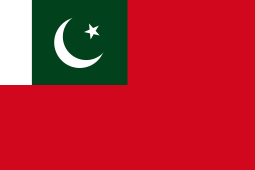Flag of Junagadh State facts for kids
 |
|
| Proportion | 1:2 |
|---|---|
| Adopted | 15 September 1947 |
| Design | State badge of a 'bezants' and 'mountains' on white disk, on a defaced Pakistani Red Ensign |
The flag of the former Junagadh State was based on the Civil State Ensign of the Flag of Pakistan. The flag has a white circle in the middle. Inside this circle, there are green shapes that look like 'bezants' (round, flat coins) and 'mountains'. The name of the state is at the top of the circle. This flag represented Junagadh, a princely state in British India.
Contents
Exploring Junagadh's Past
Junagadh was a "Princely State" in the Kathiawar Peninsula of India. It was located next to the Arabian Sea. This state was ruled by Muslim leaders during the time of the British Raj, which was when Britain ruled India. Junagadh was later taken over by India in 1948.
How Junagadh State Began
Mohammad Sher Khan Babi started the state of Junagadh in 1730. He became independent after an invasion by the Marathas. Mohammad Sher Khan Babi was the founder of the "Babi Dynasty." His family ruled Junagadh for about 200 years. First, they paid tribute to the Marathas. Later, they were under the control of the British Raj.
The Babi family came from Afghanistan. They arrived in India with Emperor Humayun's follower, Usman Khan Babi. For many years, they were loyal to the Mughal Empire. But when the Mughal Empire started to fall apart in the 1700s, the Babi family created their own independent kingdom. Sher Khan Babi, the family's leader, took control of the state in 1735.
British Influence on Junagadh
In 1807, Junagadh State became a British protectorate. This meant Britain would protect it. By 1818, the British East India Company took control. The Saurashtra area, where Junagadh was, was managed by the British under the Kathiawar Agency.
Junagadh's Decision in 1947
In 1947, India and Pakistan became independent countries. Mohammad Mahabat Khanji III, the last Babi ruler of Junagadh, decided to join the newly formed Dominion of Pakistan. This happened on August 15, 1947. The Pakistan Government accepted this on September 13, 1947.
Junagadh was mostly surrounded by India. Only one side faced the Arabian Sea. Another small state, Manavadar, which was part of Junagadh, also chose to join Pakistan. This decision was allowed under the rules for princely states joining either India or Pakistan.
After the Accession
India did not agree with Junagadh joining Pakistan. They tried different ways to pressure the state. They encouraged local leaders to join India. They also supported groups that caused unrest. The Nawab and his family left Junagadh for safety on October 24, 1947. They moved to Karachi, which was then the capital of Pakistan.
Soon after, Indian armed forces entered Junagadh. They took control of the state. Then, India held a referendum (a public vote) on November 9. Most of the people in Junagadh were Hindu. The vote showed that most people wanted to join India. Only a small number of people voted to stay with Pakistan. Junagadh had a large Muslim population, about 40%. Today, this area is still sometimes called a disputed territory by Pakistan.
Nawab Mahabat Khan III's Legacy
Nawab Mahabat Khan III is sometimes misunderstood by historians. He cared a lot about wildlife and animals. He worked hard to protect the Asiatic Lions in the Gir forests. He also helped improve the breeding of Kathiwadi horses and Gir cattle. During his rule, the large Willingdon Dam was opened. He also built the Bahadur Khanji Library and opened the Mahabat Khan free college.
After his death in 1959, the Government of Pakistan recognized the Junagadh House in Karachi. The Nawab of Junagadh Foundation Trust is also located there.
Colonial Junagadh Flag Designs



